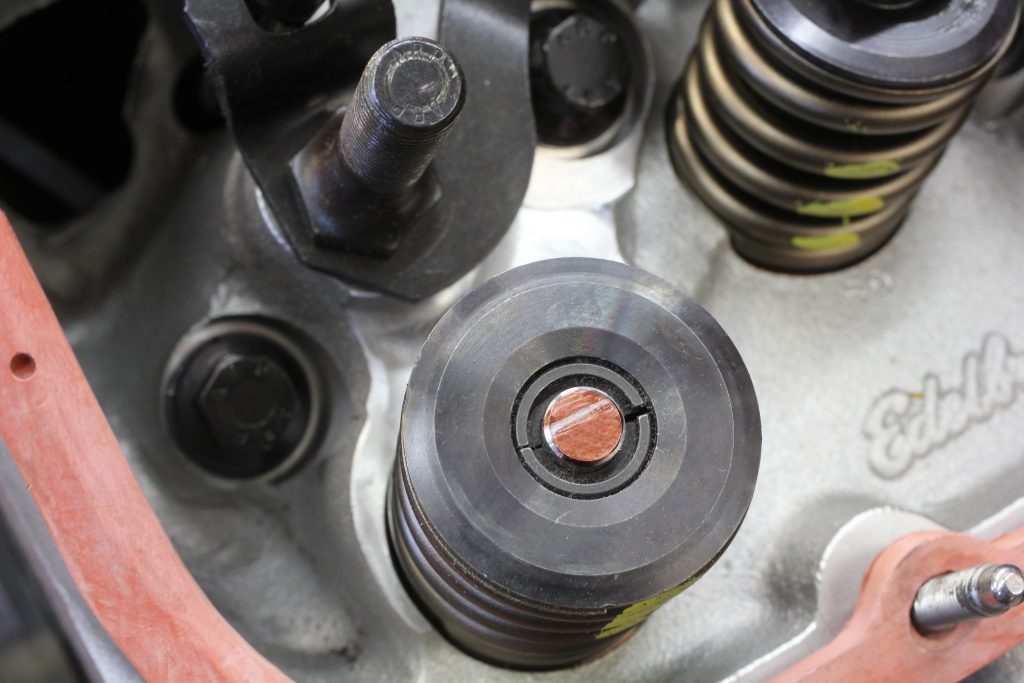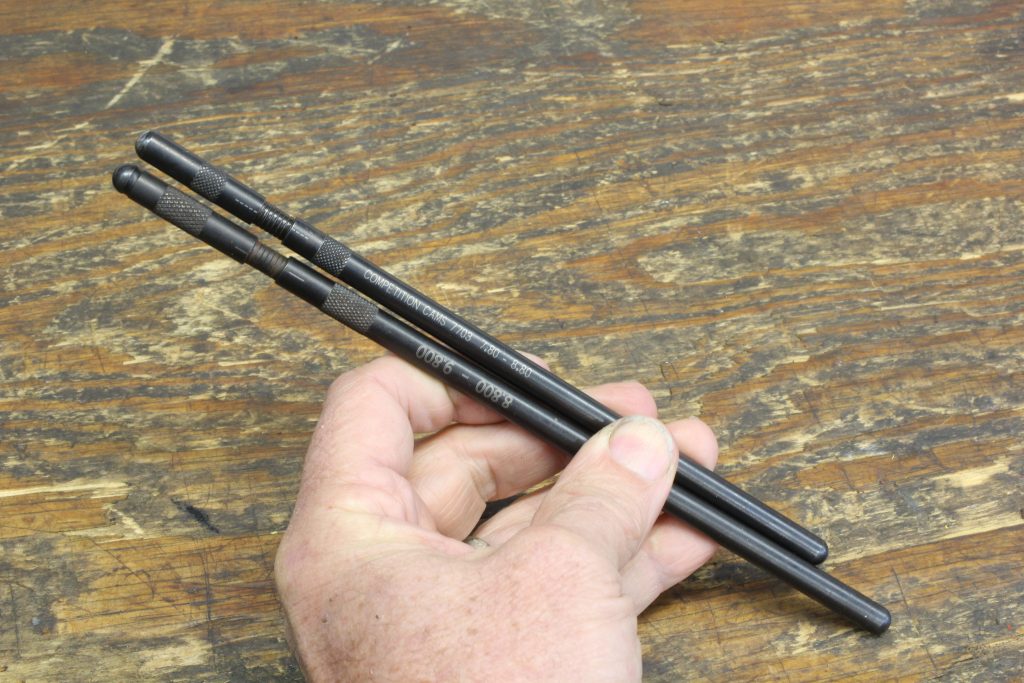I’ve got a 454 big-block Chevy that I’ve installed a hydraulic roller cam which also meant I had to also use taller hydraulic roller lifters. With it all bolted back together, it’s pretty obvious that the pushrods from the old hydraulic lifters are now way too long. How do I go about choosing the right length pushrods? I’ve read a little on the internet and looked at some cam catalogs but the pushrod lengths for these cams seem to be different. What is the right pushrod length?
J.T.
Because there are so many different variables that can affect pushrod length, a “standard length” pushrod for a high performance application, especially with a retrofit hydraulic roller, may not even be close at all to the “standard” length and certainly not optimized.
This happens because of a ton of variables such as the length of the lifter body and even small things like the reduced base circle diameter of the particular cam you are using. Cams with greater lobe lift create additional lift by reducing the base circle diameter. This directly affects pushrod length.
Measuring Pushrod Length
The easiest way to do this will involve a couple of adjustable pushrods that you can use to measure the length of the pushrod. Many years ago, Steve Lambert, the engine builder at Lingenfelter Performance Engineering, showed me how to quickly establish pushrod length and I will gladly pass along that little tip here.
To perform this length test, you will need a pair of Comp adjustable pushrods because the big-block Chevy uses different length pushrods for the intake versus the exhaust. I like to use Comp’s adjustable pushrod for this procedure because it makes coming up with the correct pushrod length really easy. Their adjustable pushrod uses an internal thread design where one turn on the two-piece pushrod moves the length of the tool exactly 0.050-inch.
Comp offers these pushrods in several individual lengths. The big block Chevy will need two different checking pushrods—the intake version accommodates lengths from 7.80 to 8.80 inches. It’s also possible that on the intake side the adjustable pushrod may need to be slightly shorter than 7.80 inches, which means you may need a second pushrod that measures from 6.80 to 7.80 inches. The exhaust pushrod tool may be longer than 8.80 inches which will require a third adjustable pushrod. (See the parts list near the bottom of this article for part numbers and links.)
How to Use Pushrod Length Checking Tools
Now we’ll get into how to use the tools properly. We will check pushrod length of Number One cylinder which is the leading cylinder on the driver’s side. Remove the valve cover and all eight spark plugs to make it easier to turn the engine over by hand. The first thing we need to do is place an original pushrod in both the intake and exhaust lifters. Now turn the engine over until the exhaust pushrod begins to rise. This tells us that the intake lifter on now the base circle of the intake lobe.
The technique to determine optimal pushrod length is simple enough. Start by using a black Sharpie to color the valve stem tip. Next, we’ll estimate the intake pushrod at roughly 7.80 inches, so install the CCA-7703-1 pushrod tool in the Number One intake lifter and then install your rocker arm. We’ll also assume you are using roller rocker arms. Set the rocker in place over the pushrod and then wiggle the rocker arm over the valve tip to create a witness mark on the black mark on the valve tip. Remove the rocker arm and find the witness mark on the valve tip.
Pushrod length plays a very important role in establishing the proper rocker arm roller tip travel across the top of the valve. If the pushrod is too short, it places the rocker arm on the very inboard side of the valve tip. If the pushrod is too long, it will place the rocker arm tip too far outboard on the valve tip. The ideal position for the rocker arm tip is roughly one-third of the way in on the inboard side. The photo at the bottom of this article will make this clear. If the witness mark is too far inboard, just lengthen the Comp adjustable pushrod until the roller rocker is roughly one-third of the way in from the inboard side.
The reason for this placement is that as valve lift is generated by the cam, the rocker arm tip will begin to travel outboard across the face of the valve tip travelling from the inboard past the centerline of the valve tip. At max lift it will be somewhere past the halfway mark on the valve tip and then begin to travel back toward its starting position as the valve closes. The ideal pushrod length will minimize the distance the rocker tip travels but it will transcribe roughly the middle half or so of the valve tip. By starting at some position roughly one-third of the way in, it will generate most of its travel across the middle of the valve tip.
Once the pushrod has been adjusted to its ideal length, all you have to do is count the number of turns out from its original length with each turn worth 0.050-inch. This means that if you turn the pushrod out three turns, this is equal to adding 0.150-inch to the starting length of the pushrod. So if we added 0.150-inch to the adjustable pushrod that starts at 7.800, the desired pushrod length would be 7.950-inch.
To perform this same technique on the exhaust pushrod, first turn the engine until the intake pushrod is approximately halfway down the closing ramp of the lobe. This will place the exhaust lobe and lifter on the base circle. Then run through the same process of establishing the ideal pushrod length.
Getting the Proper Pushrods
Once you have lengths for both the intake and exhaust pushrods, you can order pushrods from any of the pushrod companies. Nearly all the cam companies like Comp offer pushrods in 0.050-inch lengths. Then all you have to do is order eight intake and eight exhaust pushrods and the task is complete.
As a warning, don’t try to use these adjustable pushrods against regular spring pressure to check travel across the valve tip by opening and closing the valve with the rocker arm. These pushrods are intended to be used against a checking spring and will bend if used to open against normal spring pressure. If you want to measure the actual rocker travel, install a light checking spring in place of the normal valve spring.
This is a simple and effective way to establish proper pushrod length. There are other procedures that some people may comment on that are an attempt to minimize rocker travel or place the rocker at 90-degrees to the valve at mid-lift. These processes will often require a different pushrod length.
We won’t get into this on-going battle except to say that these other procedures are aimed at race engine applications for ultra-high-rpm use. The process we just offered is easy, concise, and will offer great durability on any street motor.
***
Parts List for Ask Away: Big Block Chevy 454 Pushrod Length
| Part Number | Description |
|---|---|
| CCA-7702-1 | COMP Cams Hi-Tech Pushrod Length Checking Tool, 6.80" - 7.80" (Intake) |
| CCA-7703-1 | COMP Cams Hi-Tech Pushrod Length Checking Tool, 7.80" - 8.80" (Intake) |
| CCA-7704-1 | COMP Cams Hi-Tech Pushrod Length Checking Tool, 8.80" - 9.80" (Exhaust) |
| CCA-7900 | COMP Cams Magnum Checking Pushrod Set* |
| *Master Kit: five separate adjustable pushrods from 6.125" to 11.50". | |
***



[…] I’ve got a 454 big-block Chevy that I’ve installed a hydraulic roller cam which also meant I had to also use taller hydraulic roller lifters. With it all bolted back […] Read full article at http://www.onallcylinders.com […]
[…] We won’t go too deeply into this, but pushrod length has a direct effect on where the roller rocker arm tip contacts the valve. This means pushrod length is critical to properly setting up the valvetrain so that the rocker scribes a narrower path across the valve tip. A simple search through some of our Ask Away tech answers will show you how to properly position the rocker tip on the valve tip with pushrod length. […]
Jeff Smith, what would your best calculation be for a big block Chev length push rod be using GM high Performance heads on a Merlin 1V block and 090 thousand head gasket for pump gas ….. given I know that al heads are different these actually have 20 thousand mill of them ….. I’m going to measure the length but was wondering if there’s actually a formula for this ????
Does pushrod length checker ends need to be the same as pushrods I’m using
I would like to know if the 8.280/9.252 pushrod length on a bbc 402 factory length with a solid lift cam or a hydraulic flat tapped
I have 402 bbc new roller cam 646 lift and new roller hydraulic lifters retro fit . 1.72 roller rocker and duel spring . The standard pushrods will not work. Has anyone used this application and would possibly have the lenght of push rods they used for both intake and exhaust?
Jeff Smith I already have my bbc 468 together and was running until I broke a push rod I was using stock length push rods its a 468 block deck zero I dont know how much the heads have been shaved they are LS6 bbc square port heads closed chamber 3964291 casting im running a 680 lift solid roller competition cam can I check the push rod lenght with my roller springs already bolted on my motor